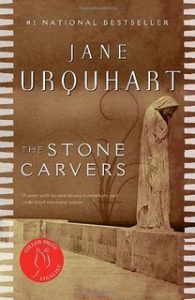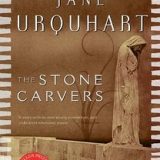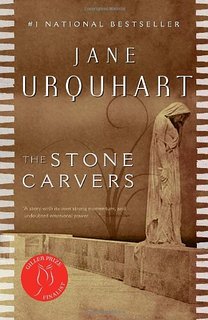The Stone Carvers – Jane Urquhart – 2001
Reviewed by: D.W. Cymbalisty Date: 1 September 2001
 The Stone Carvers is an amazing book. Ah, I just loved it… LOVED IT. If this book were a movie, the first scene might carry the caption June 1934, and the camera would pan across the vast unfinished Vimy Memorial being built near Arras in France. Workers would be chipping away at the imposing base of the structure, painstakingly carving into the white stone the name of one of the more than 11,000 soldiers whose final resting place was unknown… other workers would be on scafolding or suspended from ropes, five stories high, chiseling statues from the massive pillars as the wind whistles by them.
The Stone Carvers is an amazing book. Ah, I just loved it… LOVED IT. If this book were a movie, the first scene might carry the caption June 1934, and the camera would pan across the vast unfinished Vimy Memorial being built near Arras in France. Workers would be chipping away at the imposing base of the structure, painstakingly carving into the white stone the name of one of the more than 11,000 soldiers whose final resting place was unknown… other workers would be on scafolding or suspended from ropes, five stories high, chiseling statues from the massive pillars as the wind whistles by them.
Then the scene would shift, perhaps the camera itself passes through a cloud, and emerges in the small village of Inzell, Bavaria… and the caption now reads May, 1866. A contented young priest on one of his daily promenades across the verdant mountainside is silently praying to the Creator of all the beauty that surrounds him. Suddenly, as he is distracted by a rare wildflower, he believes he hears the voice of God giving him a very clear directive “Go to Canada. There is much work for you to do there.”
No, I am not a screenwriter. My imagination is aided by the fact that this is (almost) exactly how Jane Urquhart begins her book. She reaches back a half century to set up the background for the main timeframe of the novel, which will be the few years just prior to the outbreak of World War I and the 15-20 years following the end of the War. The above mentioned priest (Father Gstir) reluctantly obeyed God’s instructions and came to the wild frontier of Upper Canada, where he successfully founded the village of Shoneval, Ontario. Here, he serendipitously meets the son of a Bavarian miller, Joseph Becker, who came to Canada because of the rumours he had heard about the unlimited amount of wood that was available in the forests of the New World. Joseph is a wood-carver by trade. Needing a tradesman of this type to build his church and altars, Father Gstir employs Joseph to build the church and adorn it with his carvings. “This village” gasped Father Gstir, his arms opening as if to embrace the valley, “this is why I am here. Suddenly I understand why God spoke to me in my mind, why I have been sent here.”
The scene changes yet again, and a generation has passed. The scene, and indeed the rest of the book, now focuses on Joseph’s grand-daughter… the “geist-ridden” spinster Klara Becker. “She was eccentric, as spinsters are meant to be” and she lived alone on the farm behind the church at Becker’s Corners. Urquhart tells us that “The house, which was Klara’s childhood home, had not always been empty”. And with that one sentence she brilliantly justifies a re-telling of the life of Klara Becker.
 We now see Klara growing up in this peaceful family, that does end up having its slightly dysfunctional moments. Grandfather Joseph has his heart set on Klara’s younger brother Tilman, hoping that he can make a true carver of the boy. As it turns out, Tilman is an extremely claustrophobic child whose almost daily tendency is to run away. Literally run away for days at a time. It is Klara who is more interested in carrying on the carving tradition and she has obvious skill with the chisel on wood. She inherits Joseph’s perfectionism or “a need for order” and creates beautiful works. Klara’s parents make a terrible decision one day with regard to confining the boy Tilman, and with the help of Klara, he escapes and seems to run away this time for MAYBE what looks like forever. Meanwhile, Klara experiences her first taste of love with a neighbouring lad by the name of Eamon O’Sullivan, but when war breaks out… (ah, how can I say it without saying it). I won’t. Just guess. During the war years, Klara begins to shut down inside… just as her soul was beginning to spread itself out, it seems to her that it had been unjustly shot down. Her long blonde hair is now in a knot, and she takes on the role of spinster. Meanwhile Klara’s parents pass away, and Tilman is out having adventures all of his own, landing a job and his first sense of permanence in the industrial city of Hamilton. Tilman the soldier is himself “wounded out” of the War, and over a decade passes before he hobbles back to visit his sister minus a sizeable portion of his body… and this wonderful latter half of the book is appropriately entitled “The Monument”. It is just so great that I don’t want to say anything to spoil it for readers… but this second half of the book is all about the rebirth of dreams, the following of convictions, the importance of believing in a cause… the beauty of using our creative energy to honor others. It is clear at the end of the book that it is never too late for us to taste and drink of the joys of living. Anything I say will only spoil things at this point. You must read the book to find out how it is that brother and sister end up across the Atlantic, at the very plot of ground that represents the greatest loss of each of their lives… and both receive an individual healing in a way that neither could have ever imagined for themselves.
We now see Klara growing up in this peaceful family, that does end up having its slightly dysfunctional moments. Grandfather Joseph has his heart set on Klara’s younger brother Tilman, hoping that he can make a true carver of the boy. As it turns out, Tilman is an extremely claustrophobic child whose almost daily tendency is to run away. Literally run away for days at a time. It is Klara who is more interested in carrying on the carving tradition and she has obvious skill with the chisel on wood. She inherits Joseph’s perfectionism or “a need for order” and creates beautiful works. Klara’s parents make a terrible decision one day with regard to confining the boy Tilman, and with the help of Klara, he escapes and seems to run away this time for MAYBE what looks like forever. Meanwhile, Klara experiences her first taste of love with a neighbouring lad by the name of Eamon O’Sullivan, but when war breaks out… (ah, how can I say it without saying it). I won’t. Just guess. During the war years, Klara begins to shut down inside… just as her soul was beginning to spread itself out, it seems to her that it had been unjustly shot down. Her long blonde hair is now in a knot, and she takes on the role of spinster. Meanwhile Klara’s parents pass away, and Tilman is out having adventures all of his own, landing a job and his first sense of permanence in the industrial city of Hamilton. Tilman the soldier is himself “wounded out” of the War, and over a decade passes before he hobbles back to visit his sister minus a sizeable portion of his body… and this wonderful latter half of the book is appropriately entitled “The Monument”. It is just so great that I don’t want to say anything to spoil it for readers… but this second half of the book is all about the rebirth of dreams, the following of convictions, the importance of believing in a cause… the beauty of using our creative energy to honor others. It is clear at the end of the book that it is never too late for us to taste and drink of the joys of living. Anything I say will only spoil things at this point. You must read the book to find out how it is that brother and sister end up across the Atlantic, at the very plot of ground that represents the greatest loss of each of their lives… and both receive an individual healing in a way that neither could have ever imagined for themselves.
Perhaps it would be fitting in the last scene of the movie of this book if the camera again panned across the now finished monument, now clear of all human presence… perhaps the camera again passes through a cloud, only this time it does not ever emerge at all… and the narrator says “And so the impossible happens as a result of whims that turn into obsessions.” And again, my imagination is indebted to the author who put this sentence on the last page of her book.















